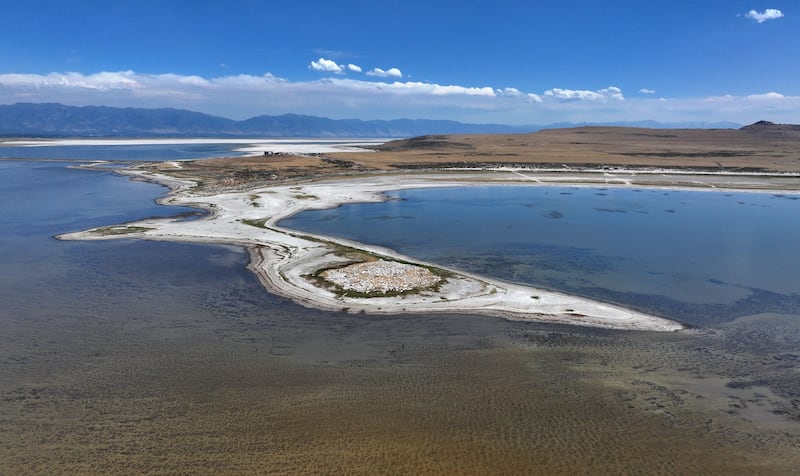The Great Salt Lake appears to have started its annual winter gains early after a rainy October, but the leader of the state agency tasked with its recovery says the lake is still much lower than it should be after another rough summer.
Its southern arm is currently at 4,191.3 feet elevation — a few inches above the lowest point recorded this year — while its northern arm remains at 4,190.8 feet elevation, according to the U.S. Geological Survey. That puts both arms approximately 1 foot below where they were this time last year, and among some of their lowest levels at the end of an irrigation season on record.
“That’s obviously lower than we’d like to see it, and that’s something that gives us all pause — and something that gives us motivation to work even harder to get things running on the Great Salt Lake,” said Brian Steed, Utah’s Great Salt Lake commissioner, in an update about lake conditions with reporters on Thursday.
The good news, he adds, is that lake salinity levels remain healthy, which is good for its ecosystem. Additionally, last month’s exceptionally high rain totals helped the lake make its winter gains a few weeks earlier than anticipated.
Last month was Salt Lake City’s wettest October on record, and it was Salt Lake and Davis counties’ ninth-wettest since 1895, according to new federal climate data released this week. Areas surrounding the lake had the highest average totals in the state, leading to other counties within its basin posting totals that were also well above normal.
This not only boosted lake elevations early but also drastically improved soil moisture levels after a lousy 2025 water year. Utah posted its 11th-driest water year on record, and counties surrounding the lake all collected totals that were well below normal.
Statewide soil moisture levels in the mountains reached 55% saturation by the third week of October, about 10 percentage points above the median average for mid- to-late October, according to Utah Natural Resources Conservation Service data. This month has been mostly drier and warmer than average, but statewide mountain soil moisture levels have remained above the median average for November.
This sets the Great Salt Lake basin up for a better snowpack runoff in the spring, where the lake makes most of its gains before the next cycle of irrigation and summer evaporation losses.
“Soil moisture content is something we watch very closely because it’s a good predictor for how good the runoffs will happen next year,” Steed said. “We have healthy soil moisture throughout the Great Salt Lake basin — in some areas as much as the top 90th percentile — and that’s a really good place to be.”
What will winter bring?
Of course, good soil moisture is only part of the spring runoff equation, and the Office of the Great Salt Lake Commissioner hopes that this winter delivers another strong winter for the basin.
Another La Niña oceanic pattern has set up for this winter, which doesn’t mean much for Utah. The state’s record-setting snowpack in 2023 came during a La Niña winter, but the pattern has also produced some of the state’s worst snowpack collections in recent memory — and many in between.
The National Weather Service’s Climate Prediction Center gives northern Utah slightly higher odds for above-normal precipitation in December, according to a new long-range forecast released on Thursday. The region is listed as having “equal chances” for both temperature and precipitation for the first three months of 2026, meaning there’s no clear signal for wetter or drier conditions yet.
Steed says he’s been monitoring the long-range forecasts closely, noting that the lake needs a “really, really big winter” to avoid being in its current position, where more microbolites and lakebed are exposed for the first time since that record snowpack.
“If you look at those predictions, they’ve kind of been all over the place,” he said. “If we can have that (October) trend continue, that would be great.”
Ongoing threats
Another half-foot of water is needed for the microbolites now, but the lake’s southern arm remains nearly 7 feet below its minimum healthy level. Steed adds that it’s why the state has no plans to stop pushing for conservation efforts, including ways to reduce consumption of the lake’s tributaries, so the lake can make a full recovery.
His update came two days after a new state audit noted that the drying of the lake is a concern for Utah’s air quality. New research this year has also pinpointed air quality concerns tied to low lake levels, including health challenges tied to dust exposure.
Students even staged a rally at the state Capitol on Wednesday in support of more funding for lake solutions.
“The Great Salt Lake isn’t just our city’s namesake; it isn’t just a tourist attraction,” said Neve Chamberlain, a Utah teen who helped organize the event. “It’s the difference between spending a life in the mountains or in a hospital.”

